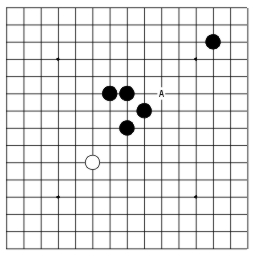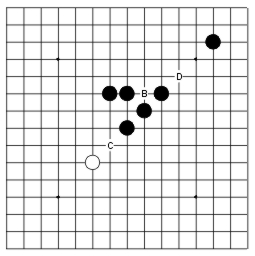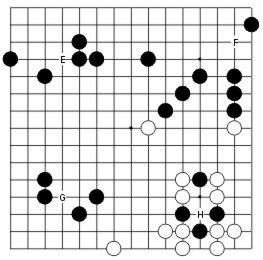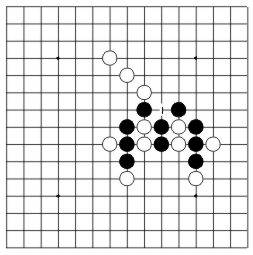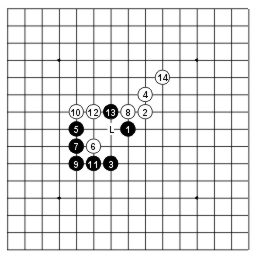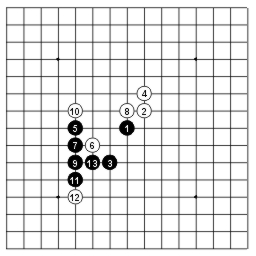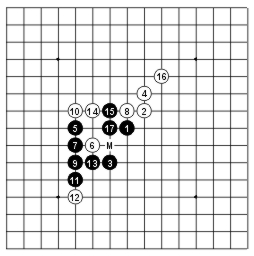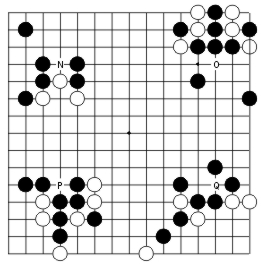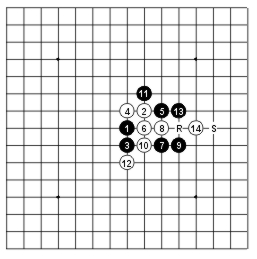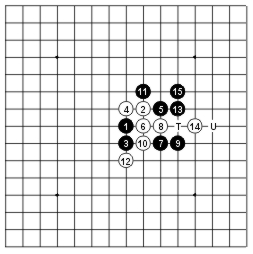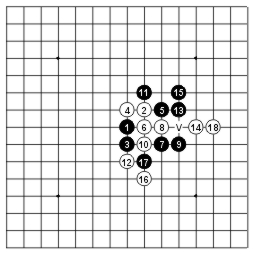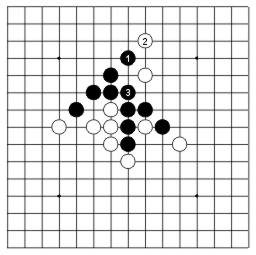|
Advanced Tutorial Welcome to the advanced tutorial. You have probably read through the basic introduction of renju in the article What is renju? by now. You are aware of all the renju rules, however, you might have some things that still confuse you, furthermore, you might want to improve your thinking in renju game. First of all, let's review the black forbidden moves in renju. They are shown on the diagram below, marked with points Y. Also, please notice that the fork at point Z is not a 3x3 because one of the threes is not an "open three", therefore the point Z is not a forbidden point.
If the forbidden point is clear, then everything is simple, but sometimes there are situations when we are not sure whether the certain point is the forbidden point or not. Look at the diagram below.
On te diagram above, we need to make sure, whether point A is the forbidden point or not. The only question here is - is the point 3x3 fork or not? In case it is real 3x3 fork, then the point is forbidden. In order to get the answer, we need to check if both threes are "open threes". Let us imagine the black stone at point A. It creates two lines (as shown on the diagram below). We see two lines that look like open threes, but we are not sure yet.
Now, lets look at the horizontal three on the diagram above. Can it then become an open four? The answer is yes, it can become an open four at point B which creates the possibility to become 5 in a row from both ends. But how about the diagonal three? Is it open too? Can it become an open four? The answer is no. If we play a four to point C, then it gets too close to the white stone, and the
four that appears on the board is not an "open four", because then the 5 in a row can be put only from the upper end. Probably you already got the idea by now. To make sure, here are four example questions for you. Are the points E, F, G and H forbidden points or not? Think for a while!
Ok, you have made up your mind by now. Let's see if you answers are correct or not. You have learned how some additional white or black stone can influence the forbidden point, and in many cases the point is legal because of that. Actually, there are more situations in renju where the seemingly forbidden point turns out to be legal. Confusing, isn't it? That is why it is so important to learn all these tricks now, so you will not be cheated by opponents in real renju games. Look at the diagram below, is the point I forbidden or not?
The situation on the diagram above looks really dangerous. White is attacking the point I. If black cannot play to the point I now, then the black will lose, because white will put winning 5 in a row there on the next move.
The question for us is, is the point I legal or forbidden. It looks like 3x3 fork. But is it? Although after playing to the point I the vertical three can become an open four, but the horizontal three is having the problem - it cannot become an open four, because both ends are blocked!! How? They are blocked by forbidden rule - both ends have the forbidden 4x4 points and black cannot play there, which means that the horizontal three is a dead line. So, there is just one real three (vertical) at point I, and the point I is not a 3x3 fork. So, black can happily play into the point I and continue the game. To give you some ideas how such situations can happen in real games, I show you one realistic example. Look at the diagram below. It is taken from the real renju game. White has been active, and with the move 22 it created the dangerous base for the attack. Move 23 - black made a three. But then white noticed, there is a chance to trap the 3x3 fork by using the white fours. First white player placed the move 24 and then 26, aiming at the 3x3 forbidden point J (threes are the stones 9,J,23 and J,25,19). But guess what! The point J is not a forbidden point at all, because after playing the black stone to the point J, the diagonal three cannot become an open four (because point K is blocked by 4x4 rule). So, since the point J is not a forbidden 3x3 fork, black can simply go there without any problems, and as a result, white will die soon. The reason of white player's loss was the fact that the white player was not careful enough or had not studied about forbidden points well enough. I hope you will not do the same mistake your games. You can see how the wrong judgement can result with the disaster in the game.
Now, look at the diagram below. With the move 11, black decided to attack. The question here is, can white trap the forbidden 3x3 or not? Think about it!
Indeed, white can really win there, trapping the 3x3 at point L. Both black threes are "open threes" and the L point is purely forbidden. White wins! Look at the diagram below how white sets up the win. Very simple!
So, the conclusion is, that black made the poor 11th move that caused the immediate loss. How could black prevent this? How could black be active, and at the same time not let whites trap the forbidden 3x3? The answer is - create an artificial block on the 3x3 fork, making one of the threes become "dead three". Look at the diagram below, black used the four first on move 11 and then played the three on move 13. How does that make a difference? Can you understand that? Why white cannot trap 3x3 now? Think about it!
The explanation to that question is shown on the diagram below. Thanks to the "help" of stone 11 black does not need to fear anything, and can bravely play to the point 17 because there is no 3x3 at point 17. Why? It is because the vertical three is a "dead three", because it cannot become an open four at point M (it's a blocked point by 4x4 rule).
So, we can now see that the four at point 11 secured the 3x3 danger and black could happily continue with a three to point 13 without worries. Beautiful, isn't it?
You have learned a lot about 3x3 and 4x4 forks. However, there are sometimes even more complex forks in renju where more than two lines cross. For example, 3x3x3 fork, 4x4x4 fork, 4x4x3 fork, 4x3x3 fork, 4x4x4x4 fork, etc. In order to imagine those forks better, look at the diagram below.
Such complex forks are real trouble for black sometimes, because they cannot be eliminated so easily. Look at the diagram below, it comes from the real game situation. With the move 14, white is aiming the forbidden 3x3 point R, planning to make the next white move to the point S. Black has to ponder about the 15th move now, trying to protect oneself from being trapped at point R.
Usually, in such danger situations there may be two defense solutions - to play to point S, to eliminate the possibility of being trapped, or to "kill" one of the black lines so that the point R is no longer a forbidden point. Let's say the black player decided to break the 3x3 at point R. Look at the diagram below.
With the beautiful moves 16 and 18 above, white wins the game!! How? The move 16 forced the black to play to the point 17, and now the point V was no longer the legal 4x3 point but it became an illegal 4x3x3 point, after which white took advantage of it and played the winning four to the point 18! Great tactics by white! You just learned how white can manipulate with the forbidden points. But at the same time, black can also skillfully handle the forbidden points whenever possible. Look at the example situation below.
On the diagram above white is attacking the forbidden 4x4x3 fork at point W. Black is in big trouble now. However, black can save itself from this trouble and even win the game! Do you see how? Think about it!
With the move 1, black plays a four. The purpose of the four was to make the vertical line become a "dead line" which does not create any four at point 3. Next, black played to the point 3, and it is a legal 4x3 fork now, consisting of one diagonal four, and one horizontal three, while the vertical line is the "dead line". So, with some skill, the black player managed to make the forbidden 4x4x3 fork become nice and legal 4x3 fork. Amazing! This is the end of advanced tutorial. I hope you got several good ideas from here and you are ready to challenge those ideas in real games. It is all fine as long as you are playing with your friends, but if you start to play in real tournaments or in online gameservers, you might need to now one more thing about renju rules, that is Starting the Game in the official renju game. |

